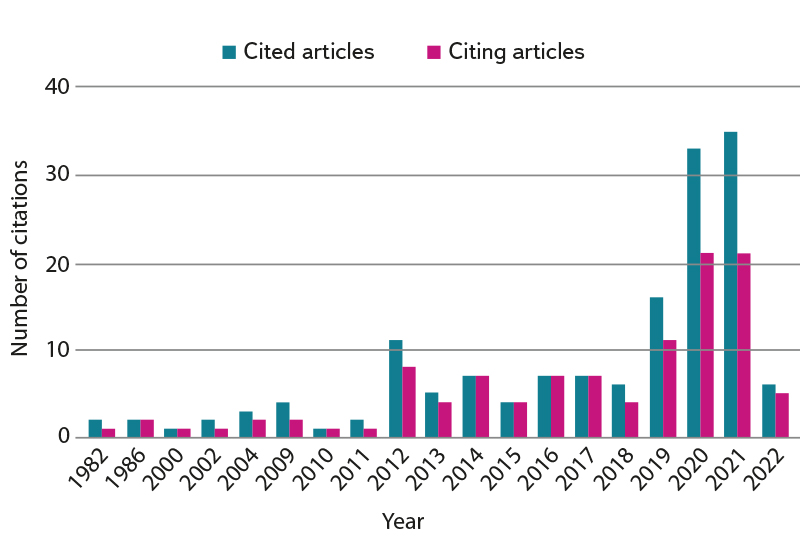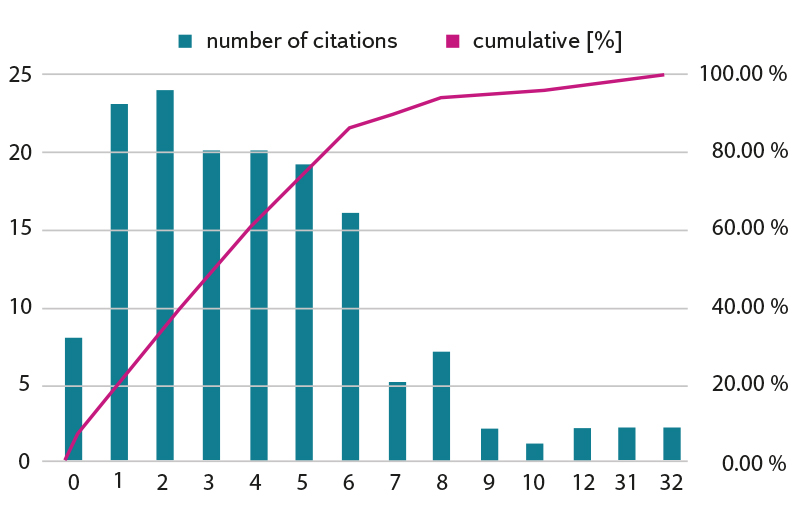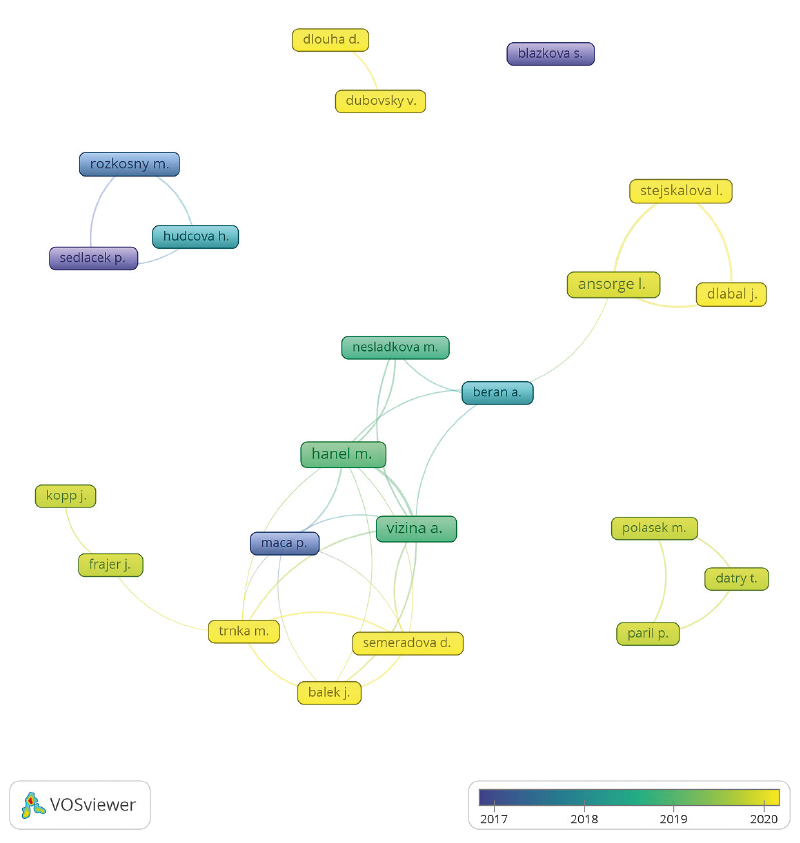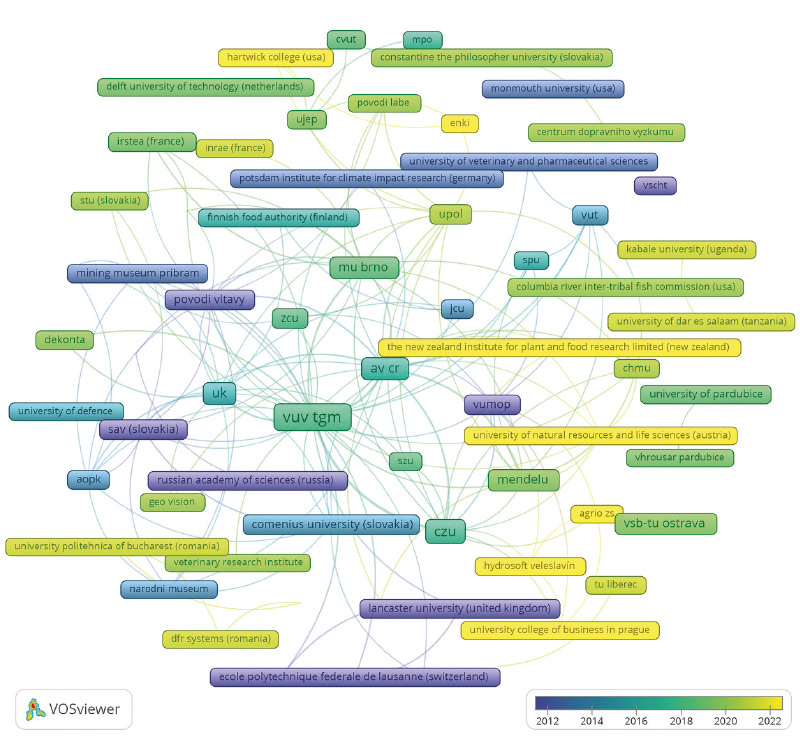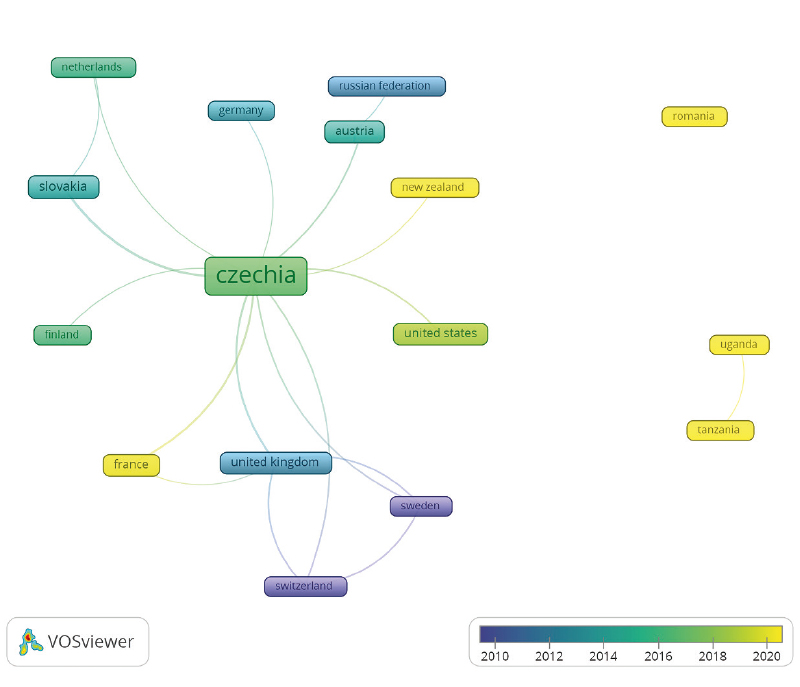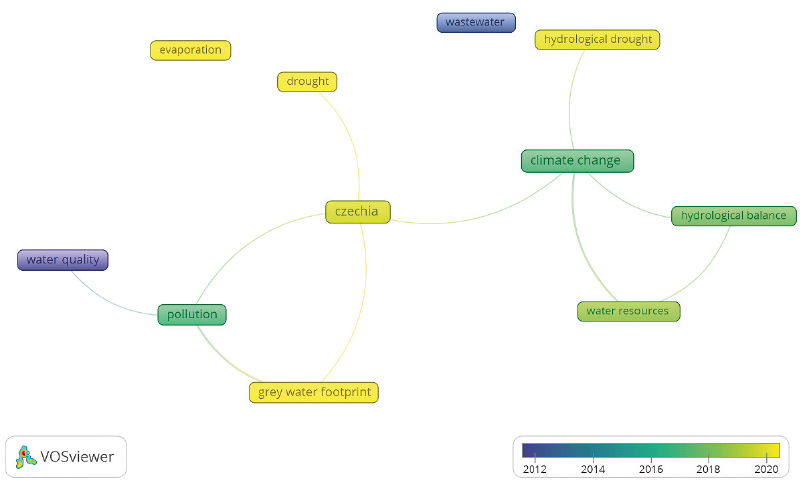SUMMARY
The citation rate of a journal is considered an indicator of its quality. This study presents a citation analysis of the VTEI journal, published by the T. G. Masaryk Water Research Institute (hereinafter TGM WRI). The citation analysis was conducted to identify the countries and institutions of authors who cite articles published in VTEI and the subject areas in which articles published in VTEI are cited. The identification of citing articles was complicated by the wide range of forms of VTEI journal title notation, as well as errors in the Scopus database. Therefore, the search was performed in several steps and the search query was gradually expanded. Descriptive statistics methods and cluster analysis using VOSviewer software were used for the analyses. A total of 126 publications were searched in the Scopus database, but only 108 publications were included in the analysis. These 108 articles quoted 152 articles published in VTEI. The number of VTEI citations has increased from sporadic citations prior to 2009 to more than 20 citing publications in 2020 and more than 30 cited publications in 2021. The majority of citations were received by articles published in VTEI within the first six years of publication, and the citation rate for articles published between 2009 and 2021 is relatively even. Authors from 66 institutions in 16 countries, mainly in Europe, contributed to the citing publications. However, authors from the Czech Republic were dominantly involved in citations and, in many cases, these were authors of articles published in VTEI. The main areas where articles published in VTEI are cited are environmental sciences, specifically the impacts of climate change on water management and hydrology, and water quality assessment using the water footprint.
INTRODUCTION
In 2021, the first citation analysis of the Vodohospodářské technicko-ekonomické informace journal (VTEI) was presented [1]. This analysis presented data on the number of citations of the VTEI journal; however, it did not deal with their more detailed analysis. Citation analysis is one of the basic bibliometric methods used, for example, in scientometrics, which enables measurement and thus mutual comparison in the field of science and research [2]. Citation analysis has been used to assess the quality of journals since the 1970s [3]. Citations of a journal serve as direct evidence of its prestige and quality [4], despite the fact that this indicator is controversial [5]. The basic citation indicator is the number of citations of a specific article, author or, in this case, journal. Simkin and Roychowdhury [6] analysed a number of citations and, based on the errors contained in them, estimated that authors read only 20 % of the works they cite. Additional indicators, such as H-index [7], G-index [8], and many others, refine the results of citation impact assessment using functions based on citation distribution [9] or functions to score articles according to “citation importance”. Most of these indicators are based on the assumption that each citation has “equal weight”, but this is generally not true. The Journal Impact Factor (JIF) is the best-known indicator for evaluating the importance of journals, which is based on dividing the total number of citations a journal receives over a two-year period by the number of articles it published in the same period [10].
Citation analysis can also be used to find answers to many other research questions, such as the structure of research teams [11], influence of frequently cited articles [12], differences in citation patterns in different fields of science [13], tracking self-citations [14] or hyper authorship [15], and collaborative networks [16]. The potential of citation analyses built on current data sources such as Scopus can only be limited by our ability to ask the right questions [17].
For citation analysis, standard bibliographic databases (Web of Science, Scopus, PubMed) are used and, in the age of Internet services, scientifically oriented indexing services (Google Scholar) and social networks (Research Gate, Academia.edu). Each of these sources has its advantages and disadvantages, and the possibilities of using them for citation analysis have been examined many times [18–20]. The two main bibliographic databases – Web of Science and Scopus – are still considered the most reliable sources of bibliographic data [21]. After all, these two bibliographic databases are also used as part of the science evaluation in the Czech Republic according to Methodology 17+. In its Core Collection, Web of Science contains more than 75 million records of articles published in approximately 21 000 journals, as well as books, chapters in them, and conference proceedings and papers in them [22]. Additional records can be found in specialized Web of Science databases. Scopus contains over 76 million records of scientific results originating from more than 39 000 journals, 120 000 conferences and 206 000 books [17].
In this study, an analysis of the citations of the VTEI journal in the Scopus bibliographic database was carried out in order to find out:
- What is the citation rate of articles in VTEI and which articles and authors are often cited?
- From which countries and institutions are the authors citing VTEI and what are the mutual links between them?
- In which areas of research are the articles published in VTEI applied?
DATA AND METHODS
Elsevier’s Scopus database was chosen for citation analysis. The reason was primarily a larger scope compared to the Web of Science Core Collection, and also a larger number of citations of the VTEI journal in 2021 [1]. Data collection was carried out in several steps, during which the search query was continuously expanded to include all citations of the VTEI journal. The number of ways to write the VTEI title in the Scopus database turned out to be problematic. In total, there are 43 forms of recording the title of the VTEI journal in the Scopus database. The abbreviation of the journal, i.e. “VTEI”, was used most often (48 times). The full title of the journal in the form of “Vodohospodářské technicko-ekonomické informace” (Water management technical-economic information) was used 32 times. The hyphen in the connection “technicko-ekonomické” was omitted in five citations, of which the diacritics were also omitted in three cases. Omission of diacritics also occurred in the other three citations. The title was often corrupted, so it was possible to find, for example, “Vodohospodá řské”, “Vodohospodárské” (6x), “Vodohospodáršké” (4x), or even “Vodohospod�rsk� Technicko-Ekonomick� Informace”, while in two cases a completely wrong title was used – instead of “technicko-ekonomické informace” “technologicko-ekonomické informace”. In the other 20 citations, a total of nine forms of shortening the full title were used. The combination of the abbreviation VTEI and the full title of the journal appeared in six citations. The translation of the title into English was used three times, but each time in a different form (The Water Management Technical and Economic Information Journal, Water management technical and economic informations, Water Management Technical and Economical Information Journal), and twice the English title combined with the abbreviation VTEI (again in different variants). Even for abbreviations of the English title, it was possible to find four variants, in a total of eight citations. In three cases, the abbreviation VTEI was associated with the journal Vodní hospodářství, with which VTEI was jointly published between 1999 and 2015 as part of a cooperation agreement [23]. During the first data collection, the search query used in the previous study [1] was applied. The resulting information was then exported to csv format and processed in a MS Excel spreadsheet. The author of the article checked which of the listed results actually cite the VTEI journal. In the event that the citing article contained more than 80 citations, which the Scopus database displays on its website, the actual original document was checked. If a cited document was indicated to be cited more than once in the Scopus database, it was also verified whether all these citing articles were included in the selection, and the search criteria was expanded as necessary.
The final data collection was carried out on 15 February 2022. The following query was used for the search: REF (“technicko-ekonomick* inf*”) OR REF (“Vodohosp* techn*”) OR REF (“Wat* manag* tech* econ * inf*”) OR REF (“Wat* manag* tech* and econ* inf*”) OR REF (vtei) OR REF (“Vodoh* Tech.-Ekon* Inf*”). As a result, 126 records were included in the analysis. Out of these 126 records found in the Scopus database, 18 records were eliminated that cited “bulletin technicko-ekonomických informací” (4x), “vtei.com” (3x), “vtei.edu.ua” (1x), “Virtually transparent epidermal imagery (VTEI)” (3x), “OBIS VTEI” (2x), and four other documents presenting technical-economic information, but not the VTEI journal. In one case (EID 2-s2.0-84907092087) there is an error in the Scopus metadata, which states that the work of the author “Vtei H” should be cited a total of 258 times in the Scopus database, but no further citations of this author or his/her works can be found there. The analysis thus included 108 records, which in 152 cases cite an article published in the VTEI journal.
For statistical data analysis, the following information was entered into the MS Excel spreadsheet:
- EID identifier of the citing article,
- DOI of the citing article,
- publication date of the citing article,
- form of the VTEI journal entry in the citing article,
- DOI of the cited article published in VTEI,
- publication date of the cited article,
- volume and issue of VTEI where the cited article was published,
- title of the cited article,
- information on whether any of the authors of the cited article were from TGM WRI,
- information on whether the cited article in VTEI has the same author as the citing article (auto-citation).
In the case of missing data on the cited article (usually the DOI, which was only added to the articles in 2020), these data were taken from the electronic versions of the articles available at https://www.vtei.cz.
Co-authorship analysis, keyword co-occurrence analysis, and author analysis were performed using VOSviewer version 1.6.17, a freely available computer program for constructing and viewing bibliometric maps [24]. Co-authorship refers to the publication of an article prepared jointly by networks of researchers, research centres, and institutions, or even countries. The so-called “co-occurrence” refers to the number of times terms appear in more than one publication [25]. VOSviewer uses a clustering technique called “VOS” (visualization of similarities) to identify networks of similar and dissimilar research objects [26]. VOSviewer creates maps that can be linked based on co-author-ship (multiple authors in one publication), co-occurrence (frequency of occurrence of two terms occurring next to each other in the text), citation
(reference to a work in the references), bibliographic links (two works referring to a third work in their bibliographies), or a link to a joint citation (links connecting two works cited by a third) [25]. For analyses using SW VOSviewer, diacritics were removed in the exported csv file and authors’ names were corrected if the export was inaccurate. Furthermore, due to an unidentified error in data interpretation by the VOSviewer program, the name “Czech Republic” was changed to “Czechia” and the names of the institutions were modified to contain only the name or abbreviation of the name of the institution, and for foreign institutions also the country. If there was an institution in the exported file with different forms of name entry, all these variants were unified, while individual workplaces, faculties, and institutes were not specified. For visualization in SW VOSviewer, so-called overlay maps were used, which display dependencies using coloured groups known as node clusters. Nodes represent authors, institutions, countries or keywords, and the colour represents the average year the article was published. Node size for authors, institutions, and countries is based on the number of published papers, references, and the reference strength of an individual author, institution, or country.
For keywords, the co-occurrence of the term in published documents and the reference strength determine the size of a node. Some nodes are close together or even clustered together, while others are further apart and even contain small clusters of their own. The closer the individual nodes are, the stronger the relationship between them.
RESULTS AND DISCUSSION
Number of citations
Despite the expansion of the search query, compared to the study from 2021 [1], there was an increase in the number of articles before 2020 by only three citations. However, the number of citing (from 13 to 21) and cited (from 22 to 33) articles increased more significantly in 2020, partly due to the expansion of the search query and partly due to the fact that the data collection for the year 2020 for the previous study [1] took place as early as on 1 January 2021, and therefore it could not include records that appeared in the Scopus database with a certain delay. For that reason, it can be assumed that even the data on citations in 2021 shown in Fig. 1 may not be definite and there may be a slight increase in their number. In the same way, other forms of writing the title of the VTEI journal can be identified (see below), which will increase the number of cited articles. However, it can be stated that prior to 2009, articles in VTEI were only sporadically cited. Since 2009, it has been cited every year.
Fig. 1. Number of articles published in VTEI that have been cited in articles indexed in the Scopus database
Of the 108 citing articles, 85 were journal articles (“article” type), 13 conference papers, 5 “review” type papers, 4 book chapters, and 1 note (“note” type). From the language point of view, 102 papers were included in the English language, eight of them were in Czech, and one paper each represented French, Polish, and Russian, while in the case of the “French” article it was actually an article in English with a French abstract. Similarly, four out of eight articles in Czech were marked as “bilingual” thanks to the English abstract (Tab. 1).
Tab. 1. Articles incorrectly marked in Scopus as bilingual
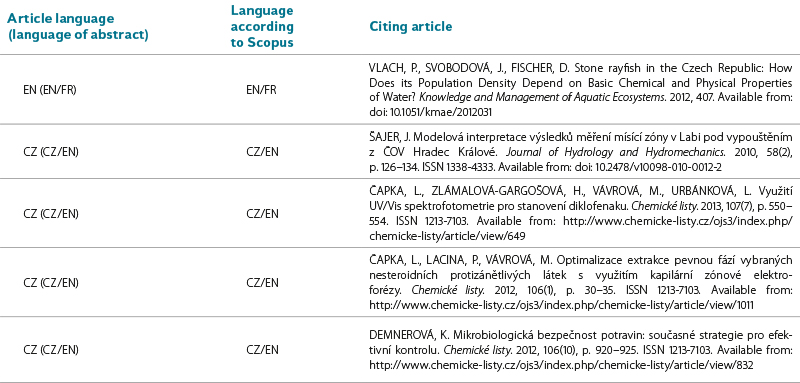
Articles citing the VTEI journal are most often published in the Swiss journal Water, published by MDPI (nine articles), four citing articles were published in the Czech journals Geografie – Sborník ČGS, and in Waste Forum and the Slovak Journal of Hydrology and Hydromechanics. Three articles were published in Chemické listy and in the IOP Conference Series Earth and Environmental Science. Other journals and proceedings published only one or two articles citing an article in VTEI.
Age of citations
The average age of a citation is 4.5 years, but this value is given for interest only, as average values should not be used in cases where the underlying distribution is highly skewed and has a long tail [27]. A total of 86 % of the articles were cited within six years of their publication (Fig. 2). Half of the articles were cited within three years of publication, and articles cited within two years of publication account for a total of 36 % of citations. Compared to the general findings [13], there is a sharp decline in the number of citations for articles older than six years. A possible explanation for this sharp decline is the fact that 152 received citations is still a relatively small number because different disciplines have different citation habits, which also change over time [28]. Rogers et al. [29] recommend a minimum sample size of 200 as an analytical minimum and 1000 samples for a good assessment of relative (but not absolute) citation performance. The sharp decline in the number of citations may also be due to the fact that articles published in VTEI before 2006 are cited sporadically (Fig. 3). However, we can also see that since 2009 there has been a relatively stable citation of approximately 10 articles each year, with the exception of 2012 and 2014, when articles received only four and one citation, respectively. On the opposite side of the spectrum, the year 2015 stands out, when the two most cited articles were published – the work of A. Vizina [30] with eight citations and S. Zahrádková [31] with seven citations. The year 2010 also stands out slightly, when an article by M. Váňa [32] was published, with five citations. 2021 and 2022 cannot yet be evaluated due to the insufficient time gap in the case of 2021, and for the fact that 2022 has not finished yet.
Fig. 2. Age of citations (difference between year of publication of the citing and the cited article)
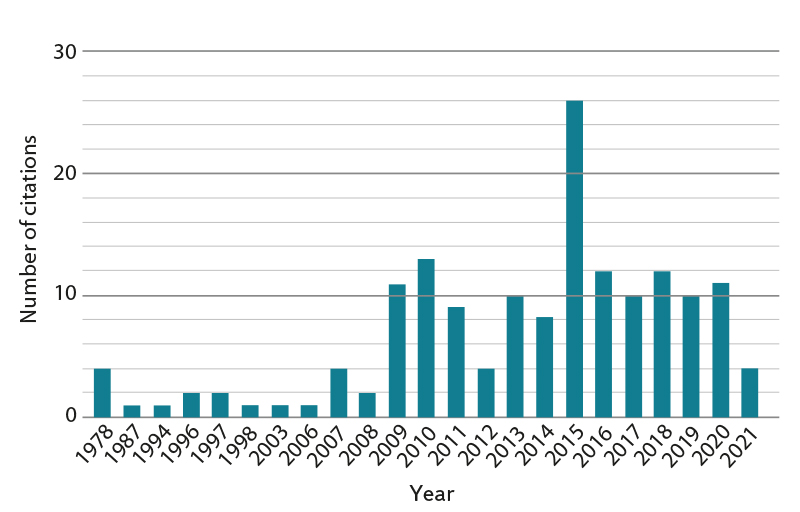
Fig. 3. Number of citations of articles published in VTEI in the relevant year
Authors citing articles in VTEI
Of the 152 cited articles, 70 (i.e. 46 %) were cited by author teams in which at least one of the authors is a TGM WRI employee. A total of 344 authors from a total of 66 institutions and 16 countries participated in writing 108 citing articles. The 22 most active authors (with three or more articles) were divided into eight clusters and these authors participated in 36 citing articles. 13 of these authors are affiliated with TGM WRI (Tab. 2). The co-authorship map created by the VOSviewer program is in Fig. 4. Cooperation between organizations is shown in Fig. 5, international cooperation in Fig. 6. Authors from the Czech Republic contributed to 97 articles (i.e. 90 %) out of 108 citing articles (Tab. 3). This confirms the earlier finding that local journals are more often cited by local authors [33]. Non-English articles also generally receive fewer citations [33, 34]. Kirchik et al. [35] showed, using the example of Russian authors, that even local authors publishing in foreign (mainly English-language) journals tend to cite articles in local languages less than when they write an article for a journal in the local language.
Tab. 2. Most active authors citing papers in VTEI journal
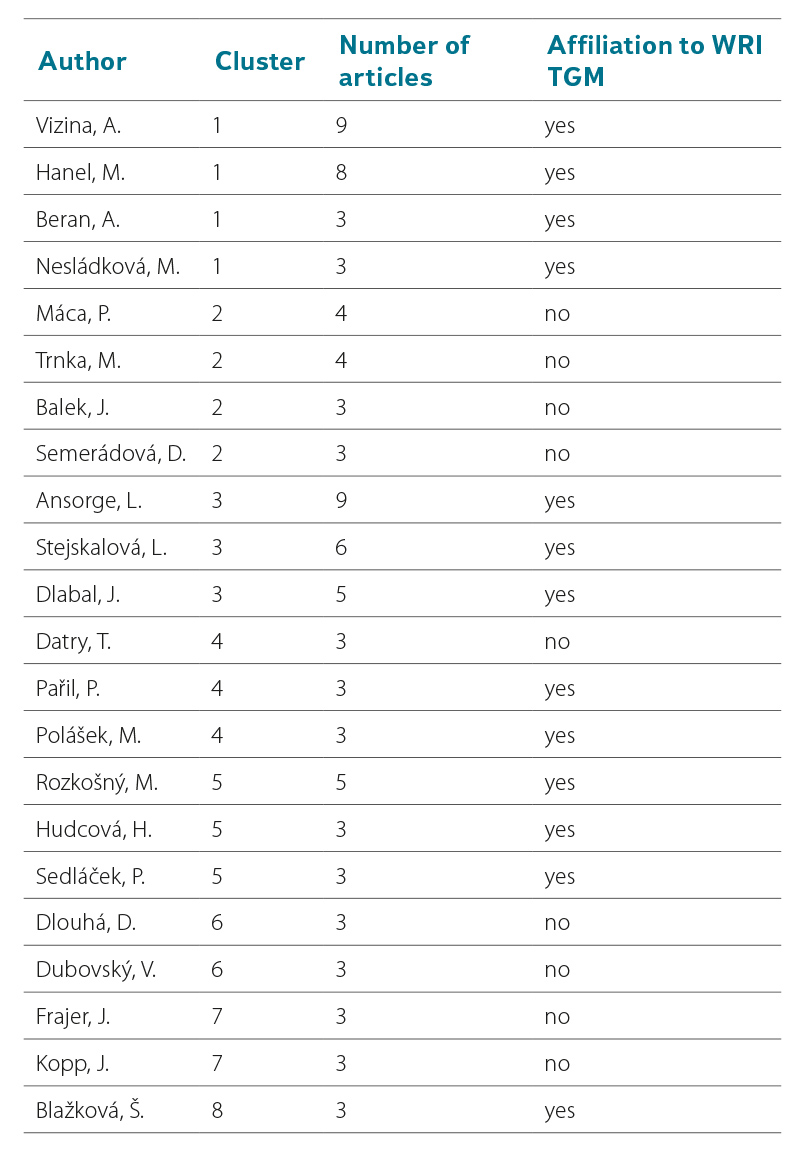
Fig. 4. Map of co-authorship who have cited the VTEI journal in at least three articles indexed in the Scopus database
Fig. 5. Map of collaboration between institutions on articles indexed in the Scopus database that cite articles published in VTEI
Fig. 6. Map of international collaboration on articles indexed in the Scopus database that cite articles published in VTEI
Tab. 3. International cooperation on articles citing papers in VTEI journal Country Cluster Number
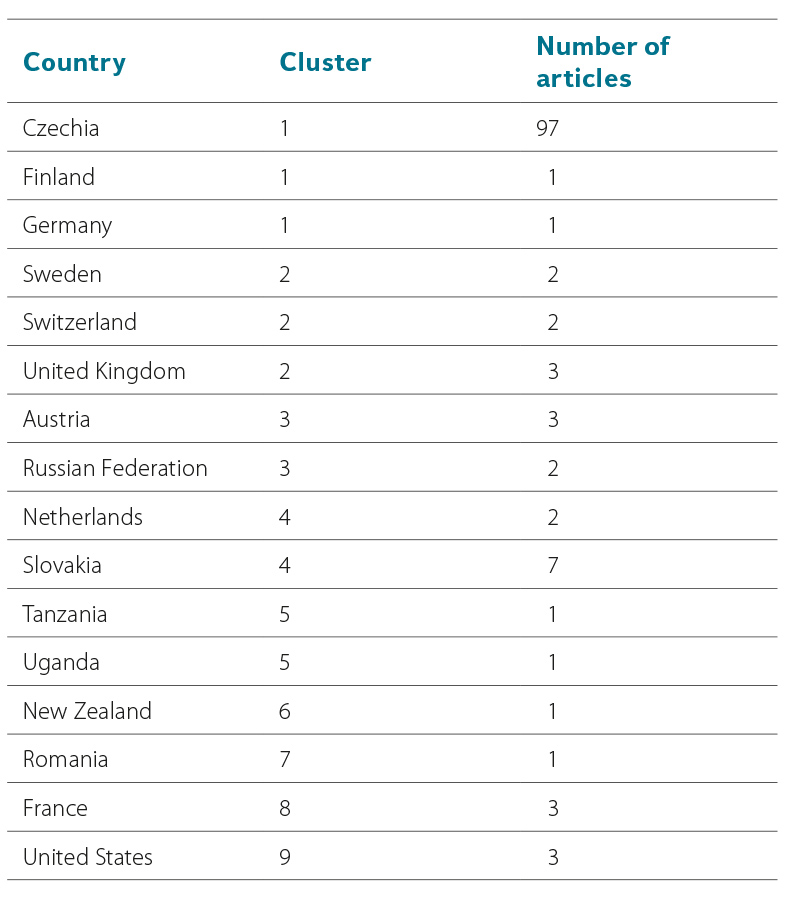
Of the 152 cited articles, 59 (i.e. 39 %) were self-cited by one of the authors of the cited article. Self-citations were used in 40 (i.e. 37 %) citing articles. Self-citations are not inherently problematic, as there are many reasons for self-citations; for example, they can refer to an earlier experiment or place the article in the context of previous works [36]. Self-citations only become a problem when they are false or unsubstantiated. Szomszor et al. [37] list a number of studies that deal with the issue of self-citations. They also designed a graphic procedure for identifying excessive self-citations, but at the same time pointed out the need for professional interpretation of individual citation profiles. A detailed analysis of self-citations was therefore not the subject of this study.
Research areas in which articles published in VTEI are cited
Classification of journals in which articles citing VTEI are published into research areas according to the Scopus database is shown in Tab. 4. The classification of individual articles that cite VTEI was carried out using keyword analysis. Keyword analysis of citing articles can identify research areas in which articles published in the VTEI journal are applied, reveal the internal relationship between research contents, and reveal the general direction of research. In addition to keyword analysis, it is possible to study the content of articles using text analysis of their titles, abstracts, or the text of the publications themselves. A total of 11 keywords were used 3 times or more in citing articles.
Tab. 4. Classification of citing articles into research areas according to Scopus
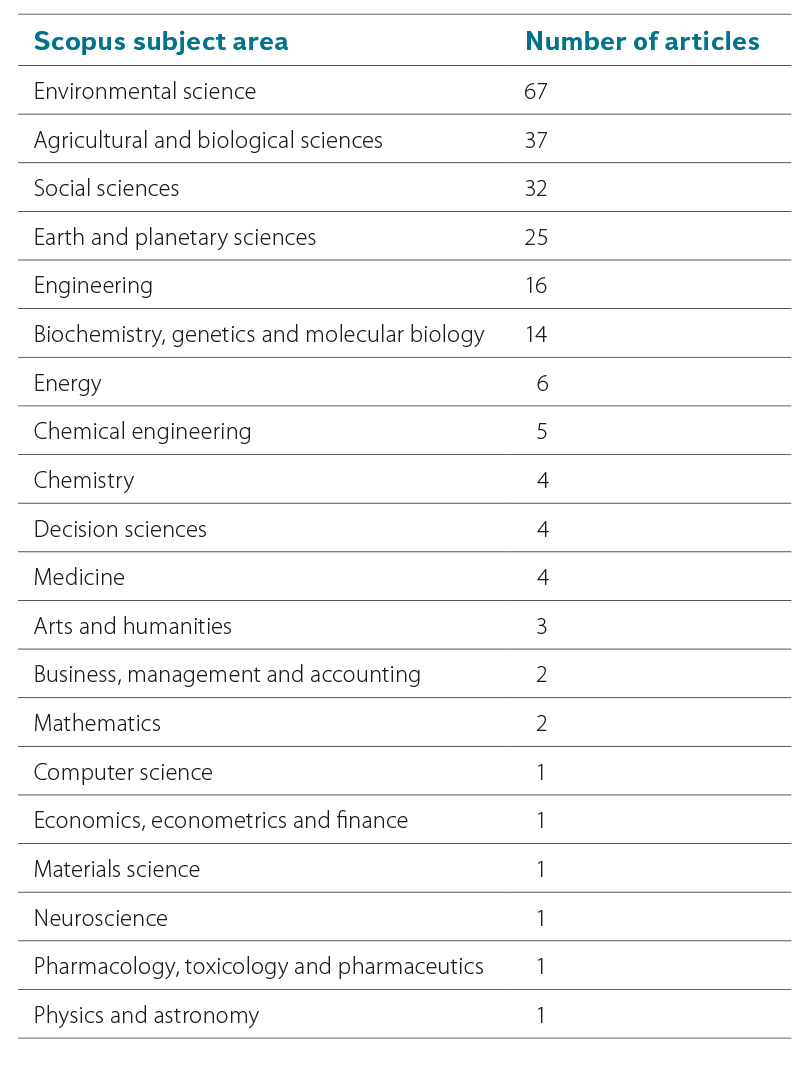
Fig. 7. Map of keywords co-occurrence (note: the map was created after the term “Czech Republic” was replaced by “Czechia”)
The keyword “climate change” was used most often (9 times) (Tab. 5). The key word map is shown in Fig. 6. It clearly shows that the cited VTEI articles mainly focus on two research areas. The first is the issue of climate change and hydrological extremes (especially drought), i.e. an area that has a direct impact on the availability of water resources. The second is the area dedicated to water pollution and its assessment, e.g. using the water footprint. These findings are not surprising considering which authors most frequently cite articles published in VTEI. They are Adam Vizina and Libor Ansorge (both with nine citations of articles in VTEI), while the team around A. Vizina is focused on hydrological research and the team of L. Ansorge on water footprint research.
Tab. 5. Keyword co-occurrence
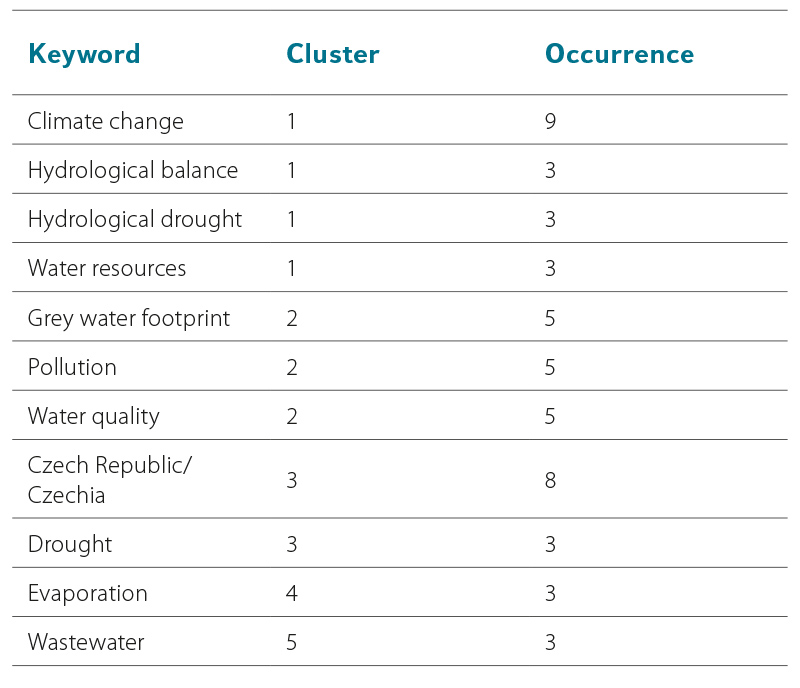
CONCLUSION
The analysis focused on the citation rate of articles published in VTEI in journals indexed in the Scopus database. As of 15 February 2022, a total of 152 citations of articles published in VTEI were found, which cited a total of 108 articles indexed in the Scopus database. The analysis of citations is especially complicated by the use of different variants of notation, and sometimes even the wrong notation of the title of the journal. Articles in VTEI have been cited by authors from 66 institutions from 16 countries. However, the majority of citations were from teams of which at least one author came from the Czech Republic and often from TGM WRI, the publisher of the VTEI journal (46 %).
From the point of view of the distribution of citations over time, three periods can be distinguished. Before 2009, articles published in VTEI are cited sporadically. After 2009, articles published in VTEI are cited regularly, while since 2018 an increased number of citations is noticeable. In 2020 and 2021, the number of cited articles exceeds 30 per year. Articles receive the majority of citations (86 %) within six years of publication.
The analysis showed that the VTEI journal is among the sources of professional information for a number of scientific teams, and not only in the Czech Republic.
Acknowledgements
This study was created with the support of the Long-Term Concept of Research Organization Development (DKRVO) of the T. G. Masaryk Water Research Institute. The author would also like to thank two reviewers for their stimulating comments during the review process, which contributed to the higher quality of the article.
